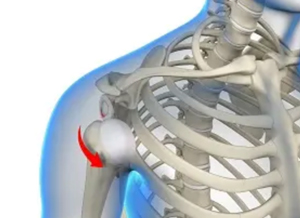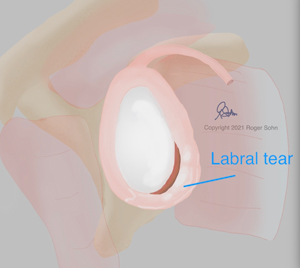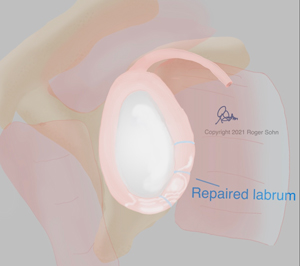Shoulder Dislocation More
By Roger C. Sohn, MD
Anatomy Of The Shoulder
The shoulder joint is a loose or “sloppy” ball and socket joint. A ball at the top of the upper arm bone (humerus) fits loosely into a socket, called the glenoid, which is part of the shoulder blade (scapula). Unlike the hip, which is a very stable ball joint, the shoulder is more like a golf ball sitting on a golf tee. The shallow glenoid socket is surrounded by a ring of fibrous cartilage called the labrum which helps deepen the socket and stabilize the shoulder joint.
What Is Shoulder Instability?
Injuries of the shoulder can cause the humerus (the upper arm bone) to come loose from the socket, leading to a condition known as instability. The instability might be associated with partial dislocations (subluxations) or complete dislocations. Both can cause pain and shoulder joint disability. The shoulder joint often dislocates in the forward direction (anterior instability), but can also dislocate backwards or in the downward direction. Often, the damage to the shoulder joint leads to further dislocations known as recurrent instability.
What Are The Symptoms Of Shoulder Instability?
The most common symptoms of shoulder instability are dislocations. Usually there is a first dislocation which is caused by a major injury. These can happen during sports or other types of injuries such as car accidents or ski crashes. Many times, the first dislocation needs to be treated in the emergency room using sedatives to relax the shoulder muscles. In some cases, patients can figure out how to put the shoulder back into the socket themselves by relaxing the shoulder and rotating it in the proper way. As more dislocations happen, the shoulder may become progressively easier to dislocate due to increasing ligament and bone damage. The shoulder will often feel very unstable in certain positions. Patients often have to modify their activities to avoid the positions of dislocation.
Diagnosis of Shoulder Instability
Your doctor will examine your shoulder and may order an X-ray to confirm the diagnosis. Often, a special MRI called an MRI arthrogram can assess the extent of the damage to the joint and ligaments. In many cases, the imaging tests will reveal a tear to the labrum, a cartilaginous rim that surrounds the socket of the shoulder. Besides labral tears, the MRI arthrogram can reveal other damage such as a Hill-Sachs lesion.
What Are The Treatments for Shoulder Instability?
The risk of further dislocations is influenced heavily by the age at the time of the first dislocation. In those who are younger than 20 at the time of the first dislocation, the chance of more dislocations is nearly 100%. For those 20-30 years old, the risk is between 70 and 82%. For those over 50, the risk is between 14-22%*
In patients in lower risk categories, options include physical therapy to strengthen the supporting muscles of the shoulder. Through rehabilitation and carefully avoiding the positions of danger, the risks of further dislocations can be reduced.
Because the risk of future dislocations is so high in younger people, surgery is often the best option. Early surgery treatment can prevent the damaging effects of additional dislocations. The shoulder can be stabilized using arthroscopic surgery. This is a minimally invasive technique which allows doctors to repair torn ligaments and in some cases to transfer a muscle to dynamically stabilize the shoulder joint. Dr. Sohn is experienced in arthroscopic ligament repairs as well as the arthroscopic latarjet procedure.
* (2016 Polyzois ABJS)
Shoulder Dislocations - Things To Know




